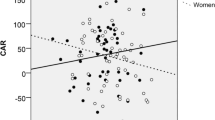Abstract
The relationship of salivary testosterone and cortisol concentrations to personality, criminal violence, prison behavior, and parole board decisions was examined among 113 late-adolescent male offenders. Offenders high in testosterone committed more violent crimes, were judged more harshly by the parole board, and violated prison rules more often than those low in testosterone. No main effects for cortisol emerged. However, as expected, a significant interaction between testosterone and cortisol was found, in which cortisol moderated the correlation between testosterone and violence of crime. Cortisol may be a biological indicator of psychological variables (e.g., social withdrawal) that moderate the testosterone-behavior relationship. Paper and pencil measures of personality and behavior showed little relationship to hormones.
Similar content being viewed by others

References
Baron, R. M., & Kenny, D. A. (1986). The moderator-mediator variable distinction in social psychological research: Conceptual, strategic, and statistical considerations.Journal of Personality and Social Psychology, 51, 1173–1182.
Bishop, D. T., Meikle, A. W., Slattery, M. L., Stringham, J. D., Ford, M. H., & West, D. W. (1988). The effect of nutritional factors on sex hormone levels in male twins.Genetic Epidemiology, 5, 43–59.
Carlson, D. A. (1971).Carlson psychological survey. Port Huron, MI: Research Psychologists Press.
Cumming, D. C., Quigley, M. E., & Yen, S. S. C. (1983). Acute suppression of circulating testosterone levels by cortisol in men.Journal of Clinical Endocrinology and Metabolism, 57, 671–673.
Dabbs, J. M., Jr. (1990). Salivary testosterone measurements: Reliability across hours, days, and weeks.Physiology and Behavior, 48, 83–86.
Dabbs, J. M., Jr., Frady, R. L., Carr, T. S., & Besch, N. F. (1987). Saliva testosterone and criminal violence in young adult prison inmates.Psychosomatic Medicine, 49, 174–182.
Dabbs, J. M., Jr., & Hopper, C. H. (1990). Cortisol, arousal, and personality in two groups of normal men.Personality and Individual Differences, 11, 931–935.
Dabbs, J. M., Jr., Hopper, C. H., & Jurkovic, G. J. (1990). Testosterone and personality among college students and military veterans.Personality and Individual Differences, 11, 1263–1269.
Dabbs, J. M., Jr., Ruback, R. B., Frady, R. L., Hopper, C. H., & Sgoutas, D. S. (1988). Saliva testosterone and criminal violence among women.Personality and Individual Differences, 9, 269–275.
Ehrenkranz, J., Bliss, E., & Sheard, M. H. (1974). Plasma testosterone: Correlation with aggressive behavior and social dominance in man.Psychosomatic Medicine, 36, 469–475.
Huizinga, E., & Elliott, D. S. (1986). Reassessing the realiability and validity of self-report delinquency measures.Journal of Quantitative Criminology, 2, 293–327.
James, V. H. T., & Baxendale, P. M. (1984). Androgens in saliva. In G. F. Read, D. Riad-Fahmy, R. R. Walker, & K. Griffiths (Eds.),Ninth Tenovus workshop: Immunoassays of steroids in saliva, (pp. 193–201). Cardiff, Wales: Alpha Omega.
Kagan, J., Reznick, J. S., & Snidman, N. (1988). Biological bases of childhood shyness.Science, 240, 167–171.
Kreuz, L. E., & Rose, R. M. (1972). Assessment of aggressive behavior and plasma testosterone in a young criminal population.Psychosomatic Medicine, 34, 321–332.
Mason, J. W., Giller, E. L., & Kosten, T. R. (1988). Serum testosterone differences between patients with schizophrenia and those with affective disorder.Biological Psychiatry, 23, 357–366.
Quay, H. C., & Parsons, L. B. (1971).The differential behavioral classification of the juvenile offender (2nd ed.). Washington, DC: Bureau of Prisons.
Rose, R. M. (1978). Neuroendocrine correlates of sexual and aggressive behavior in humans. In M. A. Lipton, A. DiMascio, & K. F. Killam (Eds.),Psychopharmacology: A generation of progress. New York: Raven.
Rubin, R. T. (1981). Sex steroid hormone dynamics in endogenous depression: A review.International Journal of Mental Health, 10, 43–59.
Thompson, W. M., Dabbs, J. M., Jr., & Frady, R. L. (1990). Changes in salivary testosterone levels during a 90-day shock incarceration program.Criminal Justice and Behavior, 17, 246–252.
Udry, J. R. (1990). Biosocial models of adolescent behavior problems.Social Biology, 37, 1–10.
Walker, R. F. (1984). Salivary cortisol determinations in the assessment of adrenal activity. In D. B. Ferguson (Ed.),Steroid Hormones in Saliva (pp. 33–50). New York: Karger.
Wolff, C. T., Friedman, S. B., Hofer, M. A., & Mason, J. W. (1964). Relationship between psychological defenses and mean urinary 17-hydroxycorticosteroid excretion rates: I. A predictive study of parents of fatally ill children.Psychosomatic Medicine, 26, 576–591.
Wolff, C. T., Hofer, M. A., & Mason, J. W. (1964). Relationship between psychological defenses and mean urinary 17-hydroxycorticosteroid excretion rates: II. Methodologic and theoretical considerations.Psychosomatic Medicine, 26, 592–609.
Author information
Authors and Affiliations
Additional information
This research was supported in part by NIMH grant MH42525 and by a Vice-President's grant from Georgia State University. We wish to thank the Georgia Department of Corrections and the Georgia Board of Pardons and Paroles for making the research possible. In addition, we specifically extend thanks to Tim Carr (Department of Corrections); to Sue Aiken, Tom Morris, and Sheila Thompson (Board of Pardons and Paroles); and to Debra Plyler and Paula Williams for coding inmate records.
Rights and permissions
About this article
Cite this article
Dabbs, J.M., Jurkovic, G.J. & Frady, R.L. Salivary testosterone and cortisol among late adolescent male offenders. J Abnorm Child Psychol 19, 469–478 (1991). https://doi.org/10.1007/BF00919089
Revised:
Issue Date:
DOI: https://doi.org/10.1007/BF00919089



